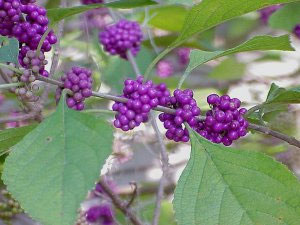

by Sharon LaPlante
Beauty
berry, Callicarpa americana, is a native shrub in the Verbenaceae
family. Its name comes from the
Greek Calli for 'beautiful' and carpa for 'fruit'.
Other common names include French mulberry, Bermuda mulberry, foxberry,
and turkeyberry. The common name
'French mulberry' comes from eighteenth century English.
The English settlers in the New World despised their French counterparts
and named this berry, which they found bland and unpalatable, after them.
Beauty
berry can be found growing in woodlands, pinelands, and thickets from Virginia
to Arkansas south to Florida. It
also occurs in Bermuda, Cuba, and Mexico. It
is generally overlooked as a landscape plant, however, when used it adds color
and texture to the landscape, as well as food for wildlife.
Both novice and expert gardener will be rewarded by its resilience and
beauty.
Propagation
is achieved readily by transplanting as well as with cuttings. Cuttings should
be kept moist while transplants should be watered regularly until they become
established. Propagation can also
be achieved with ripened seeds that have been cleaned and stored at room
temperature until the next growing season.
Each fruit contains four seeds; fresh seeds can take as long as three
months to germinate.
Individuals
grow to approximately 8 feet in height, and almost as wide, with an open
branching habit. The leaves
Small
pink flowers are found in axillary clusters, in whorls around the stem, and
appear in the spring and summer providing
food for pollinators. The nectar is an important part of the diet of many bee
and wasp species, and their attraction creates rich foraging areas for insect
eating birds and reptiles.
The
berries, which are only a quarter of an inch wide, are a beautiful magenta color
and are quite striking in winter
Although
bland, the berries are edible and can be used to make a pale, tasty jelly. The
taste is reminiscent of the
Plant
your beauty berry in full sun to part shade with dry to moist soils.
Once established it is virtually maintenance free.
Pruning is not necessary even after a frost, but pruning close to the
ground each year will generally keep the plant more compact
- approximately four feet high by four feet wide.
Growing
in a wide variety of light and soil conditions, Callicarpa is a welcome
addition to the home landscape, and the local wildlife will greatly appreciate
this additional winter food source.
By
Sharon LaPlante
Austin,
Dan. Scrub Plant Guide.
The Gumbo Limbo Nature Center of South Palm Beach.
1993
Beck,
Carol. The
Wonder World of Our Wild Plants.
Big Lake Printers; Lake Placid, FL
Bir,
Richard E. Growing
& Propagating Showy Native Woody Plants.
University of North Carolina Press: N.C.
1992
Martin,
Alexander, et al.
American Wildlife & Plants: A Guide To Wildlife Food Habits.
Dover Publications: New York, NY.
1951
Taylor,
Walter Kingsley.
The Guide to Florida Wildflowers.
Taylor Publishing: Dallas, TX
1992
Return to the Main Page
All material on this site © Hernando Chapter of the FNPS. The materials on this website may be copied and distributed without permission, provided that it is used for non-commercial, informational or educational purposes, and you acknowledge this site and the Hernando Chapter of the Florida Native Plant Society as the source of publication.